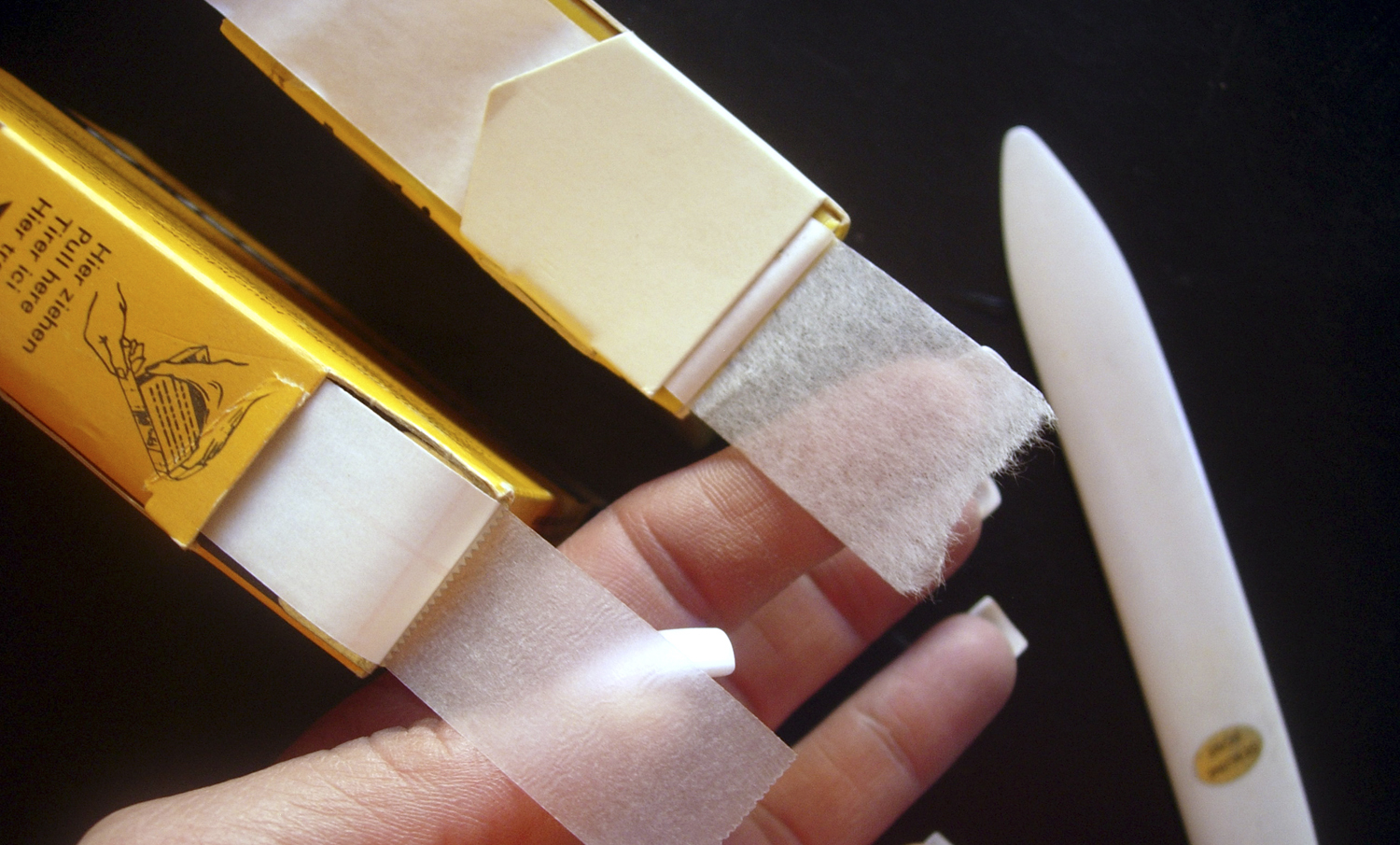 Photo 1
Photo 1
Both Filmoplast® P (L) and Lineco Document Repair Tape (R) are considered extended-term pressure-sensitive, transparent paper tapes for mending tears and reinforcing folds in maps.
An adhesive is any substance that binds surfaces together and resists separation. It is defined by properties based on the substance's physical form, chemical form, type of materials joined and/or the conditions under which it is applied. Adhesives used to create tapes are broadly divided in two classes: structural and pressure-sensitive. Structural adhesives form a bond through evaporation of solvent (water base PVA); stimulation by UV radiation (dental adhesives), chemical reaction (two part epoxy), or simple cooling (hot melt).
In contrast pressure-sensitive adhesives form a bond simply by the application of pressure as stimulation. The bond forms because the adhesive is soft enough to flow and grab. The resulting bond has strength because the adhesive is hard enough to resist additional flow when stress is applied and once the adhesive and substrate are united there is also a molecular interaction which contribute to cured bond strength. Ease of removability depends on the selected substrate, length of time it contacts the substrate and temperature during bonding. If surfaces are damp, dirty, oily, or heavily textured they will not bond as well as to a smooth surface. Plus the warmer the materials, the more aggressive the adhesive becomes.
Pressure-Sensitive Adhesives
Pressure-sensitive—a.k.a. P-S, PSA, self-stick or sticky adhesive—typically formulated from natural rubber, synthetic rubbers, and polyacrylates is an adhesive which forms a bond when pressure is applied to activate and fuse the adhesive to another surface. The special feature of pressure-sensitive adhesives is that they do not solidify but remain tacky over time. No solvent, water, or heat is needed to activate the adhesive but burnishing is required to fully activate it. Factors such as substrate smoothness, application energy (burnishing) and removal of contaminants are all important to proper bonding. PSAs are designed to form a bond and hold properly at room temperatures. and they typically reduce or lose their tack at low temperatures and reduce their shear holding ability at extreme high temperatures.
Moisture is also a physical barrier to adhesion and long term bonding making dry storage imperative. Coldness to the touch is often an indicator of moisture content in boards, so learn to feel what you are touching when selecting boards. So even though a permanent high tack pressure-sensitive may be applied at room temperature, bond failure may occur at freezing temperatures if placed outside, or in an excessively humid bathroom.
Permanent and Removable PSA
Pressure-sensitive adhesives are available for either permanent or removable applications. Permanent means impossible to remove without the destruction of the substrate or mounting. Permanent PSAs may be initially removable but build adhesion to a permanent bond once cured after several hours or days. Historically, coated papers are the most difficult to adhere (RC photographs) because of their lack of absorption and require softer more aggressive pressure-sensitive adhesive to bond well, making high tack PSA the best choice.
Removable PSAs are designed to form a temporary bond, and ideally can be removed after months or years due to the drying out of the adhesive tackifiers leaving some degree of residue on the substrate and/or artwork. Removable adhesives are used in the production of masking tapes, pricing labels and promotional graphics materials. Some removable adhesives are designed to repeatedly adhere and release. They have low adhesion and generally cannot support much weight, such as post-it notes.
Just as removable pressure-sensitives may not always remove, permanent pressure-sensitives may not always be permanent. Never select a pressure-sensitive product without knowing the exhibition conditions, or where and how the project is to be used.
Low, Medium, High Tack
P-S adhesives are produced with low, medium, and high tack adhesion. Typical downward pressure or quick rub applied to adhere a pressure-sensitive tape only activates about 25% of the adhesive. Firmly rubbing with a burnisher will active nearly 80%, then weighting during curing will allow for maximum fusion. High tack PSA is the most aggressive and more difficult to apply manually than medium or low tack because of its immediate grab and lack of repositioning potential. It immediately grabs to a smooth nonporous or coated stock—like photos—with no forgiveness, is most often applied with rollers, and was traditionally geared to the commercial market.
Medium tack PSA has been the type most used in framing, and is available as immediate tack and repositionable until burnished. The benefit of having a repositionable PSA is peace of mind, but the trade-off is loss of a longer term more aggressive bond. Repositionable PSA is somewhat repositionable during mounting with porous papers, but even repositionable P-S boards will grab more aggressively to a smooth or coated material.
Low tack PSA is a very temporary, nonaggressive bond—post-it notes, name tags—that is not suitable for the longevity that framing demands. It is best used as a temporary positioning tack in preparation for other bonding, as with HA adhesives and vinyl laminates—such as D&K Expression® Finish Guard™ UV Films or Drytac Artshield™ heat-activated laminating films—where they are implemented for basic alignment prior to dry mounting.
Pressure-Sensitive Tapes
Pressure-sensitive tape consists of a PSA coated onto a carrier such as paper, plastic film, cloth, or metal foil. It is tacky without heat or solvent activation and adheres with pressure. These tapes usually have a release liner backing to cover the adhesive until desired for use. Single-sided tapes allow bonding to a surface or overlapping of materials. Double-sided tape has adhesive on both sides—ATG—allowing the joining of items back-to-back.
Filmoplast® P is used in libraries for mending tears in paper. It is considered an extended-term pressure-sensitive, transparent paper tape made from a special lignin free paper. Once burnished down it virtually disappears into the paper, leaving a mend that both looks and feels like the original page. Both the adhesive and paper are buffered with Calcium Carbonate making the tape slightly alkaline at pH 9.2 designed to counter acids in the paper it is applied to. It may be suitable for mending tears in pages, and reinforcing folds in maps and other papers which can also be used for labels and sticks to Mylar. Another lightweight document mending tape is Lineco Document Repair which is non-yellowing and removable with mineral spirits. (photo 1)
 Photo 1
Photo 1
Both Filmoplast® P (L) and Lineco Document Repair Tape (R) are considered extended-term pressure-sensitive, transparent paper tapes for mending tears and reinforcing folds in maps.
Filmoplast P90 is a calcium carbonate buffered pH 8.7 white paper tape, which is long fibered and heavier weight for repairing joints, book hinging, and book pages. Filmoplast SH is an aggressive high tack self-adhesive fine threaded linen tape used for hinging hard covers to the book block, book hinging and where extreme strength and durability is needed, but not hinging art. (photo 2) Though all Neschen Filmoplast tapes are made of inert and stable adhesives they are not to be considered a replacement for traditional conservation hinges made from wheat paste and rice paper.
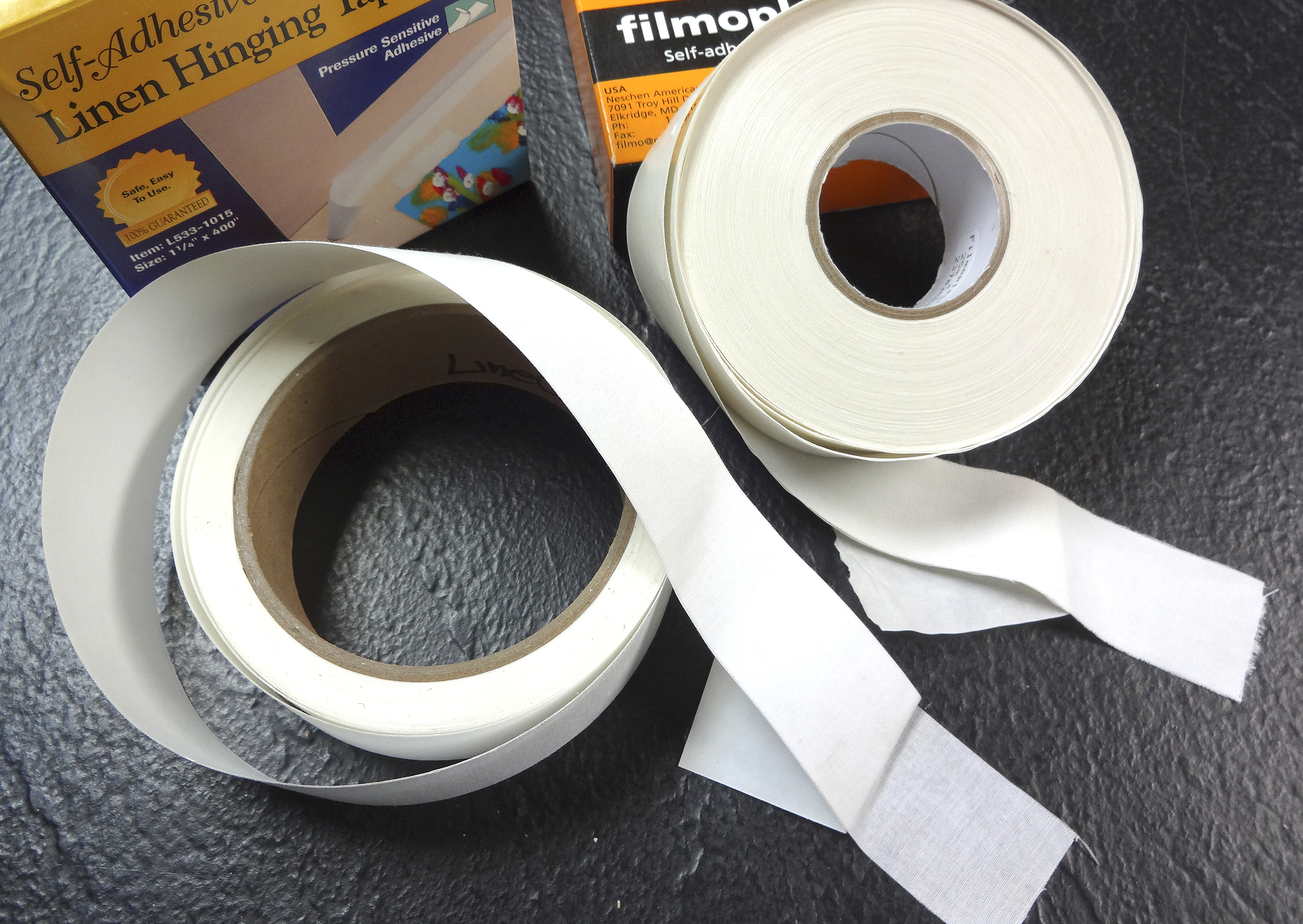 Photo 2
Photo 2
P-S linen tapes are aggressive high tack tapes used for hinging hard covers to the book blocks, book hinging of mats and where extreme strength and durability is needed, but not hinging art.
P-S Sealing Tapes
Developed specifically to seal backing board to frames, Lineco Sealing Tape is a paper carrier backed with a foil layer and non-yellowing, permanent acrylic adhesive which attaches firmly to almost any surface and conforms well to surface irregularities. It also provides an effective barrier for the rabbets of wooden frames, fillets and is available in white or blue/gray.
Self-Adhesive I-Film Frame Sealing Tape features a polyethylene embedded with a copper matrix which is coated with acrylic adhesive. It is flexible, strong and puncture resistant adhesive that readily sticks to raw wood which helps retard acids, corrosive gases, and resists mold and mildew. (photo 3)
Tyvek® Tape is an aggressive pressure-sensitive is great for hinging mats, binding folder spines, book repair and frame sealing. It is a polypropylene film with acrylic adhesive that handles temperature extremes from -40ºF to 220ºF, is moisture and UV resistant preventing water and air infiltration making it good for insulation and as a vapor barrier. (photo 4)
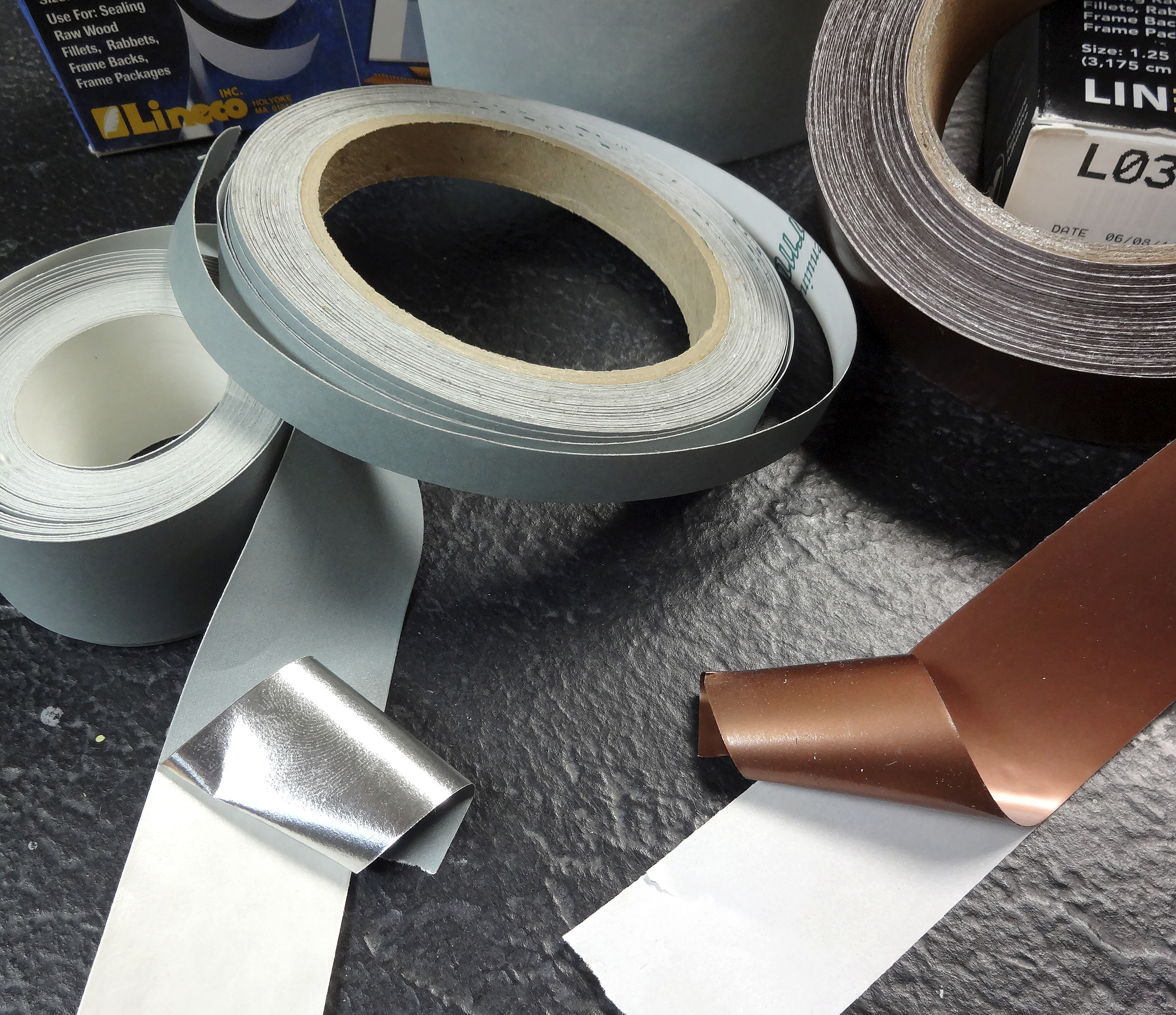 Photo 3
Photo 3
Lineco Frame Sealing Tape (L) with a foil barrier is available in various widths. Self-Adhesive I-Film Frame Sealing Tape (R) is a polyethylene embedded with copper.
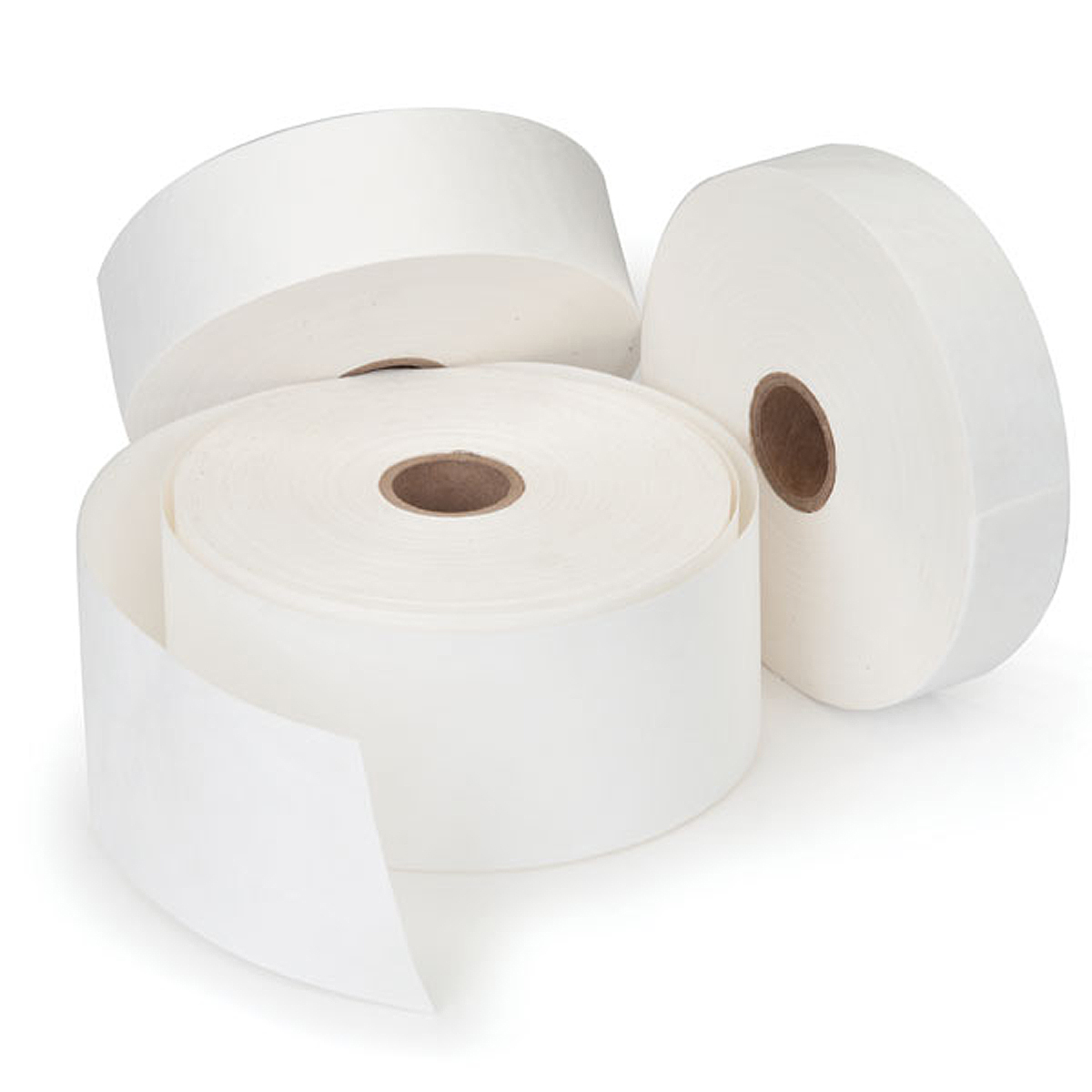 Photo 4
Photo 4
Tyvek® Tape is a polypropylene film with an aggressive acrylic adhesive for book hinging mats, book repair and frame sealing.
P-S Roll Adhesives
P-S films are available with and without carriers. 3M Positionable Mounting XE "Positionable Mounting Adhesive (PMA)" —Adhesive (PMA) is a medium tack, 100% adhesive film with a release liner. Having no carrier, the adhesive is delicate and easily pulls apart when handled and allows for self-shaping. PMA is not recommended by the manufacturer for mountings larger than 20"x24".
Neschen gudy® 870—a.k.a Gudy-O—often called a film or transfer adhesive is a thin, high tack polyacrylic ester adhesive film like a double-sided tape with no carrier coated to a silicone coated release liner. It is a pressure-sensitive with a pH 7 which will not dry out or discolor with age, can be removed by jelling the adhesive with acetone or xylene and then rubbing. Since it does not have a center carrier it is well suited for irregular shapes like those found in memory albums or montage imagery.
Crescent Perfect Mount Self-Adhesive is a medium tack P-S film on a polymer carrier with P-S adhesive and release liners on both sides. This allows the adhesive sheet to be handled more aggressively without pulling apart, though it will stick to your fingers, get dirty, and could wrinkle. It is neutral pH, trims cleanly with a blade, is repositionable until burnished and requires weighting while curing to maximum bond.
Neschen gudy® 831—a.k.a. Gudy V—is a very aggressive high tack acrylic adhesive on a paper carrier making it well suited for application on rough or textured surfaces. It is acid and solvent-free, will not dry out or become brittle with age, and has passed the Photographic Activity Test (ISO 18932) making it ideal for permanent mounting of photographs. Similar in application to a wide roll of double-sided tape gudy 831 can be used to make any smooth surface a self-adhesive substrate using a roller laminator.
Water Activated Adhesive
Gummed or water activated adhesive is a class of colloidal substances from plants, which is sticky when moist and is composed of complex carbohydrates and organic acids which are soluble or swell in water and are sometimes categorized as natural resin. Water activated tape—a.k.a. gummed paper tape, gummed tape or licky-sticky tape (UK)—is starch or animal glue base adhesive on a carrier of paper or linen which becomes sticky when moistened. An animal glue is an adhesive that is created by boiling of animal connective tissue such as horse, rabbit or fish. Gummed tapes are water activated adhesives that can be acid free, lignin-free, with buffered paper carriers that will support most artwork, though starch is preferable for hinging. Wide water activated tapes are also available reinforced with fiberglass threads which are great for closing and sealing boxes. These tapes—including Gummed Kraft Paper Tape—are strong and dependable but are not acid free and should be limited to packaging and shipping.
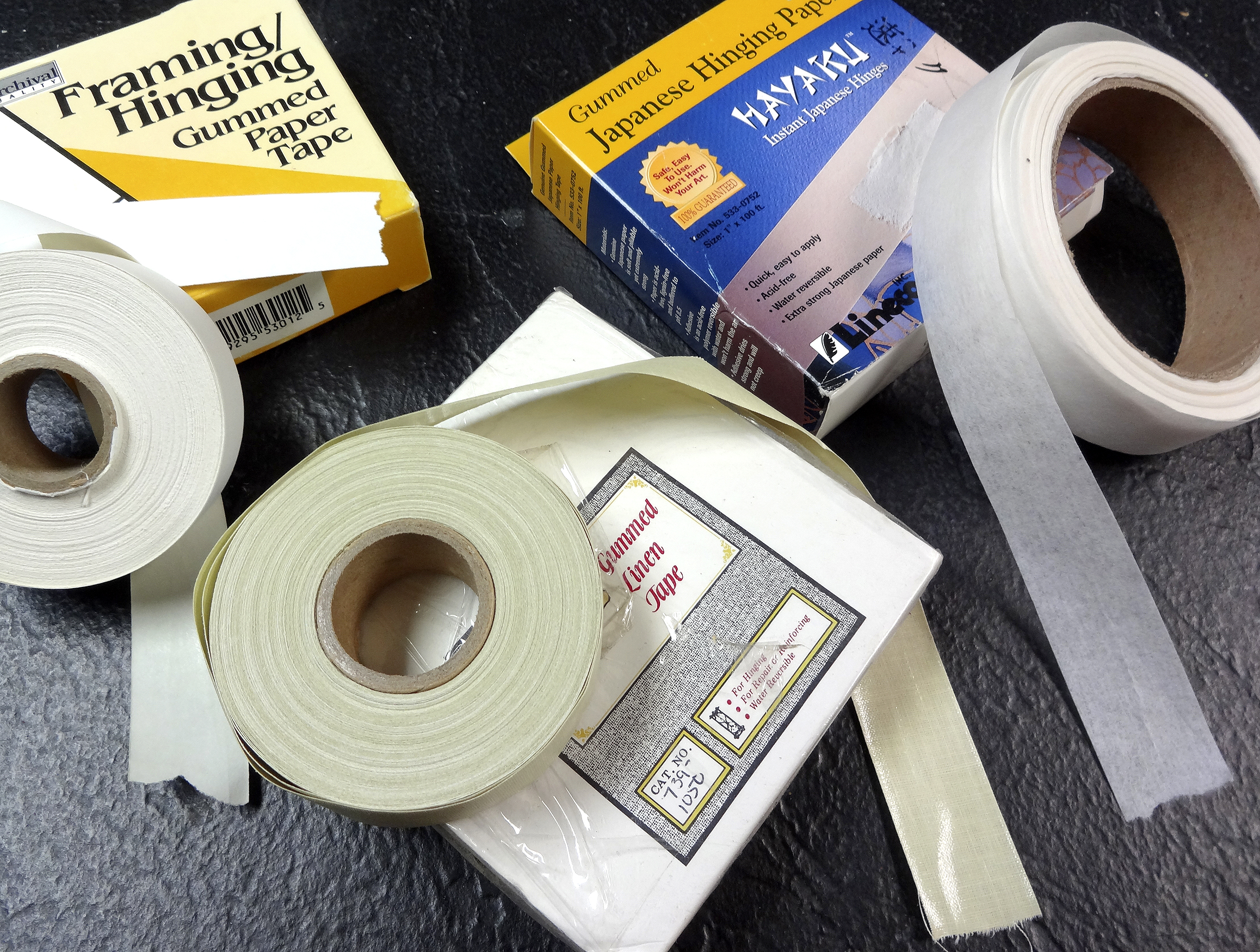 Photo 5
Photo 5
Gummed water activated tapes (L to R) include Lineco white linen, natural linen for book hinging mats or repair and Hayaku sheer rice paper hinging tape.
Lineco carries a line of gummed paper and linen tapes comprised of a water activated neutral pH high tack adhesive and 65/55 thread count fabric providing superior strength for mat hinging or book repairs. Gummed Cambric Tape is a water activated adhesive on white cotton cloth linen neutral pH tape available 1", 2" and 3" wide from Talas. It is recommended for use in book hinging, frame sealing and finishing off the sides of stretched canvases that are unframed. They also sell a small device for moistening gummed adhesive tapes and any other water activated adhesive product. The drum rotates on shaft suspended above a water reservoir that doesn't dry out or disintegrate like a sponge. (photo 5)
Hayaku is a water activated tape on Japanese mulberry paper. It is coated with acid free, starch adhesive used for preservation hinging art on paper and repair of art and bookbinding and is reversible with water. Always allow water moisture to soak up into water-activated hinges rather than risking removal of any adhesive through the action of brushing water onto the tape.
Thoughts On Tape
Tapes should never be placed in direct contact with artwork or photograph, regardless of whether they are acid free or not. Damage can occur from all P-S adhesives over time. Even water soluble brands will only remove the tissue carrier and not the adhesive saturation that has occurred. Both self-adhesive and PVA gummed paper tape will chemically react and cross-link with atmospheric pollutants after about ten years rendering the new adhesive substance insoluble, and nonremovable.
PASCHKE NOTE TO READERS: The term archival has been avoided in this article and is no longer used in ISO standards having become too ambiguous, and meant to imply forever. The new phrase extended-term will replace archival to meet the specifications set in ISO 18916-Photographic Activities Test for enclosure materials (PAT).
END
Copyright © 2014 Chris A Paschke
Resources—Items
http://asaptapes.com—Art and frame tapes
http://lineco.com—Abaca.sa, Gummed tapes, Tyvek tape, Volara tape
http://framewareinc.com—Lineco tapes
http://gaylord.com—Lineco, Filmoplast
http://talasonline.com—Cambric Tape, Lineco, Hayaku, Filmoplast, Gudy
http://universityproducts.com—Gummed Linen, Lineco, Filmoplast, Sealing tapes
http://framingsupplies.com—PS and Gummed Tapes, 3M, Lineco
http://lightimpressionsdirect.com—Tyvek tape, Filmoplast, 3M
http://innotape.com—3M, ATG, bulk purchasing
http://specialtytapes.net—ATG, shipping tapes
For more articles on mounting basics look under the mounting section in Articles by Subject.
Additional information on all types of mounting is found in:
The Mounting and Laminating Handbook, Second Edition, 2002,
The Mounting And Laminating Handbook, Third Edition, 2008 and
Creative Mounting, Wrapping, And Laminating, 2000 will teach you everything you need to know about getting the most from your dry mount equipment and materials as an innovative frame designer.
All books are available from Designs Ink Publishing through this website.
Chris A Paschke, CPF GCF
Designs Ink
Designs Ink Publishing
785 Tucker Road, Suite G-183
Tehachapi, CA 93561
P 661-821-2188
chris@designsinkart.com